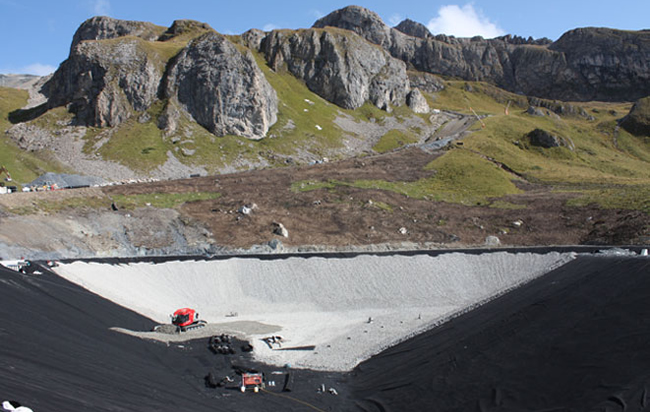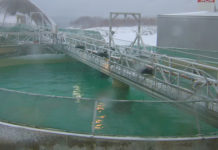Ischgl is an internationally renowned ski resort in the Silvretta Mountains of Tyrol. Plenty of natural snowfall supports 200km of downhill pistes (compacted snow runs), but the ability to provide artificial snow early in the season enables the resort to open sooner and gives skiers a longer and more dependable window for time on the slopes.
Large reservoirs are needed to support artificial snow production for these resorts. For mountainous locations like Ischgl, reservoir stability must be carefully monitored and quick corrections are sometimes needed.

Photo by Tourismusverband Paznaun – Ischgl. The nearly 60,000 m3 of water storage in the new artificial snow-supporting reservoir enabled the renowned resort to open earlier than ever in 2017.
See AGRU’s project note on the installation.
A NEW ARTIFICIAL SNOW SUPPORT RESERVOIR
The new reservoir Viderböden is the heart of the snow-making system for Ischgl. The project was initiated after landslides threatened the previous storage pond’s location. The site operator Silvrettaseilbahn AG identified a new, geologically secure section of slope on which to construction a new reservoir. It also specified an updated lining system to ensure efficient containment of water and which could provide long-term support in the difficult, Alpine environment.
The resulting design provided 60,000 m³ of water storage to guarantee snow reliability.
To ensure the least amount of disruption to the resort’s infrastructure, the new reservoir was placed as close as possible to the previous one without sacrificing geotechnical safety. This placement enabled the new storage facility to efficiently connect to the existing and extensive water network pipelines that support artificial snow production. New earthworks were minimized, as a result.
In just 3.5 months, the heart-shaped reservoir was constructed and sealed with high-density polyethylene (HDPE) geomembrane, per waterproofing standards in accordance with Austrian Standard (ÖNORM) S 2073, which also included a protective geotextile and gravel cover.

Photo by AGRU. The structured geomembrane provided exceptional frictional characteristics and stability for the steep installation.
Along the way, the steep slope angle challenged the construction, but it also gave the engineering team an ideal situation with which to utilize the impermeable containment performance of the HDPE lining system. The steep embankment enabled more usable depth, so the reservoir could store a greater volume of water without altering the surface area design. For the resort, it meant a greater amount of artificial snow could be called upon if needed.
A structured geomembrane—MICROSPIKE High Grip waterproofing membrane—was used. The surface of the geomembrane offers ≥20,000 knobs/m² for enhanced frictional characteristics and stability on sloped installations (along with protective and drainage pathways). The knob-free welding areas on the HDPE panels facilitated clean, efficient seaming for system integrity. In addition, the material was energetically enriched (BIO +) in order to reduce the growth of algae and enable the production of artificial snow at higher temperatures.
IMMEDIATE, BENEFICIAL IMPACT
The reservoir was completed in October 2017, which enabled Ischgl to open its slopes on November 23—its earliest start date on record.
Learn more about AGRU’s geosynthetic manufacturing, engineering expertise, and global operations at www.agru.at. See also, www.agruamerica.com.












